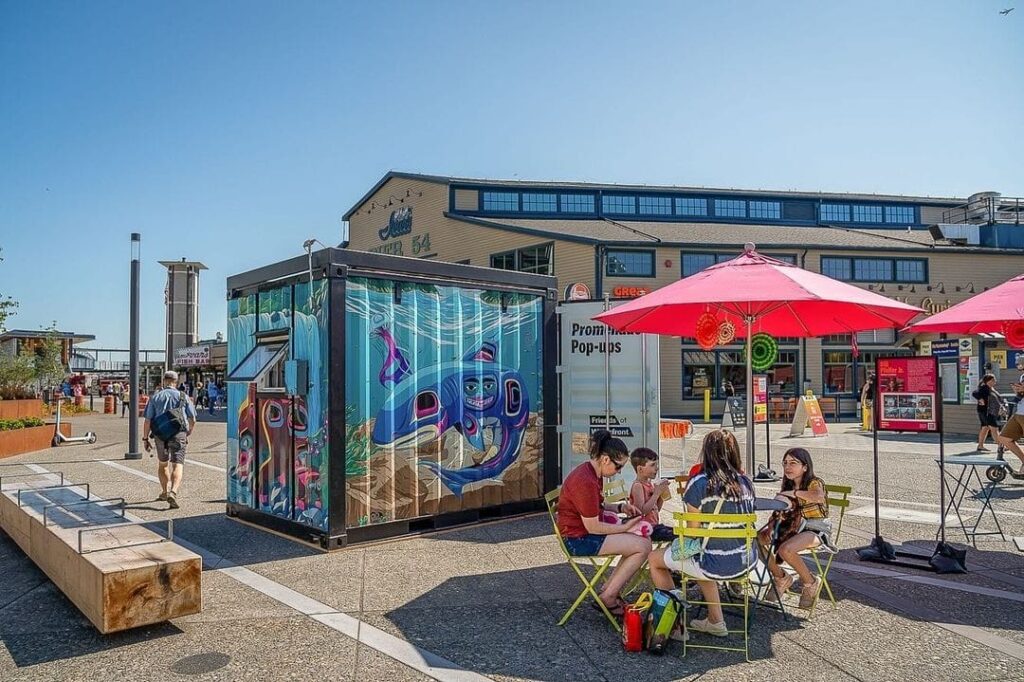In recent years, container homes have captured the imagination of architects, designers, and homeowners alike. With their eco-friendly appeal, cost-effectiveness, and modern aesthetic, shipping container homes are transforming the housing market. This article delves into the trend of container homes, examining their benefits, challenges, and what you need to know if you’re considering one for yourself. Exploring the Trend of Container Homes
What are container homes?
Container homes are residential structures made from shipping containers. These containers, typically used for transporting goods across the globe, are repurposed and transformed into livable spaces. They come in various sizes, with the most common being 20-foot and 40-foot containers.
These containers are robust and designed to withstand harsh weather conditions at sea, making them durable and long-lasting as homes. Additionally, they offer flexibility in design, allowing for creative configurations and expansions by stacking or joining multiple containers. This modular nature enables homeowners to easily adapt their living spaces to their needs. Exploring the Trend of Container Homes
Benefits of Container Homes
Container homes offer numerous advantages, making them an attractive option for many.

Cost-Effective
One of the primary benefits of container homes is their affordability. Used container homes for sale can be significantly cheaper than traditional homes. The cost of a used container can be as low as a few thousand dollars, and even with modifications, the total cost can be less than building a conventional home.
Moreover, the construction process for container homes can be less labor-intensive and require fewer materials, which further reduces costs. The savings can be substantial, freeing up budget for customization, interior design, or even additional containers for expansion. This financial flexibility makes container homes an appealing choice for first-time homeowners or those looking to downsize.
Eco-Friendly
By repurposing old shipping containers, you are contributing to recycling and reducing waste. This is a significant environmental benefit, especially considering the increasing emphasis on sustainable living. Each repurposed container means one less large steel box ending up in a landfill or rusting away unused.
Additionally, container homes often incorporate other sustainable practices, such as using recycled materials for interiors and installing energy-efficient systems. Solar panels, green roofs, and rainwater harvesting systems are common additions that enhance the eco-friendly nature of these homes. This commitment to sustainability can significantly reduce the homeowner’s carbon footprint.
Quick Construction
Prefab shipping container homes can be constructed much faster than traditional homes. Once the design and planning are complete, a container home can be assembled in a matter of weeks, compared to months or even years for conventional homes.
This speed not only accelerates the move-in process but also reduces labor costs and minimizes the impact of construction on the surrounding environment. Rapid construction is particularly advantageous in areas with urgent housing needs or for those looking to quickly establish a second home or rental property. The efficiency of prefab container homes makes them a practical and appealing option.
Challenges of Container Homes
While container homes offer many benefits, there are also some challenges to consider.
Insulation and Temperature Control
Shipping containers are made of steel, which can make them extremely hot in the summer and cold in the winter. Proper insulation is crucial to making the home comfortable year-round. This can add to the initial cost and complexity of the build.
Effective insulation involves not just the walls but also the floor and ceiling and may require specialized materials to combat condensation. Additionally, incorporating heating and cooling systems designed for small spaces is essential for maintaining a comfortable living environment. Addressing these issues early in the planning phase is critical to ensuring a habitable and enjoyable home. Exploring the Trend of Container Homes
Zoning and Building Codes
Also before nuying a cargo container home, it’s essential to research local zoning laws and building codes. Some areas may have restrictions or may not permit container homes at all.
Navigating these regulations can be complex and may require consultations with local authorities or professionals experienced in container home construction. Securing the necessary approvals and permits can take time and might involve modifications to the initial design. Understanding these legal requirements upfront can help avoid costly delays and ensure the project proceeds smoothly.
Different Types of Container Homes
There are various types of container homes available, each with its own unique features and benefits.

Modular Shipping Container Homes
Modular shipping container homes are built using multiple containers joined together to create larger living spaces. These homes can be customized to suit individual needs and preferences.
The modular approach allows for a high degree of flexibility, enabling homeowners to expand their living space over time by adding more containers. This method is ideal for those who anticipate changes in their living requirements, such as growing families or the need for a home office. The adaptability of modular designs makes them a popular choice among container home enthusiasts.
Prefabricated Shipping Container Homes
Prefabricated, or prefab, shipping container homes are built off-site and then transported to the desired location. This can save time and reduce on-site construction challenges.
Prefab homes are typically constructed in controlled environments, which can lead to higher-quality builds and fewer weather-related delays. Once completed, these homes are delivered and installed quickly, minimizing disruption to the site and surrounding area. Prefabrication offers a streamlined approach to container home construction, combining efficiency with high standards of craftsmanship.
Storage Container Homes
Storage container homes utilize standard storage containers as the primary building material. These homes can be an excellent option for those looking for a cost-effective and practical solution.
Often, storage container homes are simpler in design and may serve as temporary or semi-permanent housing solutions. They can also be used for specific purposes, such as guest houses, studios, or workshops. The straightforward nature of storage container homes makes them a versatile option for a variety of applications.
How to Buy a Container Home
If you’re interested in buying a container home, here are some steps to guide you through the process.
Research and Planning
Before you start, it’s crucial to do thorough research. Look into different types of container homes, such as container home kits or prebuilt container homes, and decide which best suits your needs. Consider factors like size, layout, and budget.
Understanding your own requirements and limitations will help narrow down the options. Investigate different designs and floor plans, and think about how they will fit into your lifestyle and future plans. This initial research phase is vital for setting realistic expectations and ensuring you make informed decisions.
Find a Reputable Builder
Finding a reputable builder is essential. Look for builders with experience in constructing container homes. Shipping container builders can provide valuable insights and help you navigate potential challenges.
A skilled builder will understand the intricacies of working with steel containers and be able to offer practical solutions to common issues. Check reviews, ask for references, and view previous projects to gauge the builder’s expertise. Collaboration with an experienced professional can significantly enhance the quality and success of your container home project.
Secure Financing
Financing a container home can be different from a traditional home mortgage. Some lenders may be hesitant to finance a non-traditional home. Look for lenders who specialize in alternative housing or consider alternative financing options.
Options such as personal loans, home equity loans, or specialized container home financing programs might be available. It’s important to understand the terms and conditions of any loan and to ensure that it aligns with your financial situation and project timeline. Securing the right financing is a crucial step in bringing your container home vision to life.
Obtain the necessary permits: Exploring the Trend of Container Homes
Starting construction, ensure you have all the necessary permits. This may include zoning permits, building permits, and inspections. Failure to obtain the proper permits can result in fines and delays.
Working closely with local authorities and your builder can help streamline this process. Each location has its own specific requirements, so thorough research and compliance are essential. Having all permits in place ensures that your container home is legally compliant and safe for occupancy.
Container Homes in Specific Locations
Container homes are gaining popularity in various locations, including South Carolina. Container homes in South Carolina offer a unique and affordable housing option for residents. Exploring the Trend of Container Homes
Container Homes South Carolina
South Carolina has seen a rise in the number of container homes due to their affordability and quick construction time. With the state’s favorable climate, container homes can be a practical and stylish choice.
The scenic landscapes and mild weather conditions in South Carolina make it an ideal location for container homes. Residents can enjoy the benefits of container living while taking advantage of the natural beauty and outdoor activities available in the state. The growing acceptance of container homes in this region reflects their versatility and appeal.
Used Container Homes for Sale
For those on a tighter budget, used container homes for sale can be an excellent option. These homes can be refurbished and customized to meet individual needs.
Buying used containers is a cost-effective way to start a container home project, and many used containers are still in excellent condition. With some creativity and effort, these containers can be transformed into beautiful, functional living spaces. Refurbishing used containers also supports sustainability by giving these steel structures a new purpose.

Conclusion
Container homes are a fascinating trend in the housing market, offering a blend of affordability, sustainability, and modern design. Whether you’re looking for a cheap shipping container home or a luxurious modular shipping container home, there are options available to suit various needs and budgets.
By understanding the benefits and challenges of container homes, doing thorough research, and working with experienced builders, you can create a unique and functional living space that stands out in today’s housing market. Embracing this innovative and eco-friendly housing option can lead to a rewarding and sustainable lifestyle.
If you’re considering making the leap into the world of container homes, now is a great time to explore this innovative and eco-friendly housing option. The versatility and potential of container homes make them an exciting and viable alternative to traditional housing.